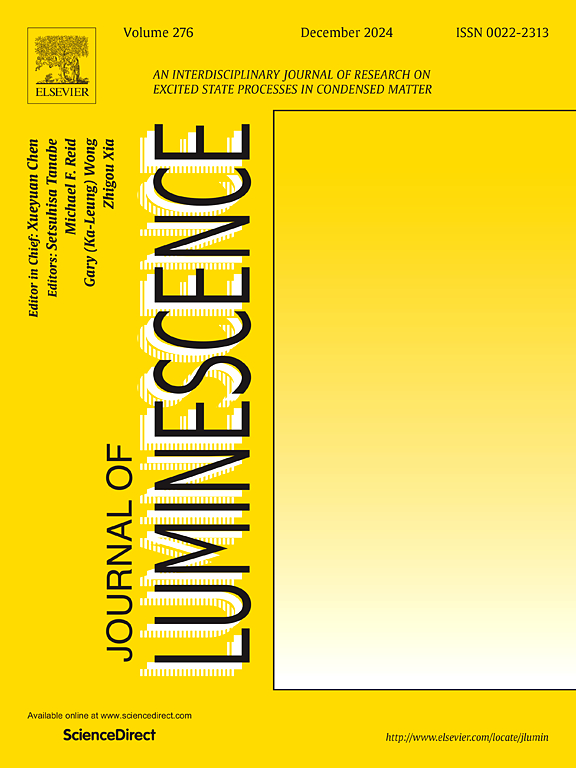新型Sm3+掺杂Sr4Ca2W2O12荧光粉用于白光LED的发光和结构特性研究
IF 3.3
3区 物理与天体物理
Q2 OPTICS
引用次数: 0
摘要
采用传统的固态反应(SSR)方法合成了一系列Sm3+离子掺杂的Sr4Ca2W2O12荧光粉,研究了它们在红橙发光方面的应用潜力。本文介绍了Sr4Ca2W2O12作为一种具有单斜晶结构(空间群P1 21/c1)的寄主基质,并利用JCPDS卡号进行了粉末x射线衍射(XRD)验证。96-210-4689。通过记录所合成的荧光粉的扫描电镜(SEM)图像,对其表面形貌和微观结构进行了研究。傅里叶变换红外光谱(FT-IR)证实了特征官能团的存在。通过漫反射光谱(DRS)估计了光学带隙,拉曼光谱显示了100-1000 cm−1范围内的主动振动模式。在407 nm激发下,荧光粉在647 nm处表现出强烈的红色发射,对应于Sm3+离子的4G5/2→6H9/2跃迁。确定最佳掺杂浓度为x = 3.0 mol%,超过该浓度会发生猝灭。优化后的荧光粉CIE色度坐标为(0.606,0.391),相关色温(CCT)为1625 K,色纯度为99.45%,适合于暖红橘色发光。光致发光(PL)衰减曲线表现为双指数行为,温度相关的PL (TDPL)研究证实了优异的热稳定性,在160℃下保持62.1%的发射强度,活化能(ΔE)为0.286 eV,相对较高的量子效率(60.17%)。这些性质表明,Sr4Ca2W2O12:Sm3+荧光粉是增强白光发光二极管(w- led)和显示技术中的红色成分的可行候选材料,解决了当前磷光转换led中红色发射差和色纯度低的挑战。本文章由计算机程序翻译,如有差异,请以英文原文为准。
Study on the luminescence and structural properties of the novel Sr4Ca2W2O12 phosphors doped with Sm3+ for high color purity in white LED applications
A series of Sm3+ ions doped Sr4Ca2W2O12 phosphors was synthesized via the traditional solid-state reaction (SSR) method to investigate their potential for reddish-orange luminescence applications. This study introduces Sr4Ca2W2O12 as a promising host matrix with a monoclinic crystal structure (space group P1 21/c1), confirmed by powder X-ray diffraction (XRD) using JCPDS card no. 96-210-4689. The surface morphology and microstructure of the synthesized phosphor has been examined by recording the scanning electron microscopy (SEM) images for the titled phosphor. The Fourier transform infrared (FT-IR) spectroscopy confirmed the presence of characteristic functional groups. The optical band gap was estimated through diffuse reflectance spectroscopy (DRS), and Raman spectroscopy revealed active vibrational modes in 100–1000 cm−1 range. Under 407 nm excitation, the phosphor exhibited strong red emission at 647 nm, corresponding to the 4G5/2 → 6H9/2 transition of Sm3+ ions. The optimal doping concentration was determined to be x = 3.0 mol%, beyond which concentration quenching occurred. The optimized phosphor demonstrated CIE chromaticity coordinates of (0.606, 0.391), correlated color temperature (CCT) of 1625 K, and excellent color purity of 99.45 %, indicating its suitability for warm reddish-orange emission. Photoluminescence (PL) decay profiles showed bi-exponential behavior, and temperature-dependent PL (TDPL) studies confirmed excellent thermal stability, retaining 62.1 % emission intensity at 160 °C with an activation energy (ΔE) of 0.286 eV and relatively higher quantum efficiency (60.17 %). These properties suggests that Sr4Ca2W2O12:Sm3+ phosphor is a viable candidate for enhancing the red component in white light-emitting diodes (w-LEDs) and display technologies, addressing the challenge of poor red emission and low color purity (CP) in current phosphor-converted LEDs.
求助全文
通过发布文献求助,成功后即可免费获取论文全文。
去求助
来源期刊

Journal of Luminescence
物理-光学
CiteScore
6.70
自引率
13.90%
发文量
850
审稿时长
3.8 months
期刊介绍:
The purpose of the Journal of Luminescence is to provide a means of communication between scientists in different disciplines who share a common interest in the electronic excited states of molecular, ionic and covalent systems, whether crystalline, amorphous, or liquid.
We invite original papers and reviews on such subjects as: exciton and polariton dynamics, dynamics of localized excited states, energy and charge transport in ordered and disordered systems, radiative and non-radiative recombination, relaxation processes, vibronic interactions in electronic excited states, photochemistry in condensed systems, excited state resonance, double resonance, spin dynamics, selective excitation spectroscopy, hole burning, coherent processes in excited states, (e.g. coherent optical transients, photon echoes, transient gratings), multiphoton processes, optical bistability, photochromism, and new techniques for the study of excited states. This list is not intended to be exhaustive. Papers in the traditional areas of optical spectroscopy (absorption, MCD, luminescence, Raman scattering) are welcome. Papers on applications (phosphors, scintillators, electro- and cathodo-luminescence, radiography, bioimaging, solar energy, energy conversion, etc.) are also welcome if they present results of scientific, rather than only technological interest. However, papers containing purely theoretical results, not related to phenomena in the excited states, as well as papers using luminescence spectroscopy to perform routine analytical chemistry or biochemistry procedures, are outside the scope of the journal. Some exceptions will be possible at the discretion of the editors.
 求助内容:
求助内容: 应助结果提醒方式:
应助结果提醒方式:


